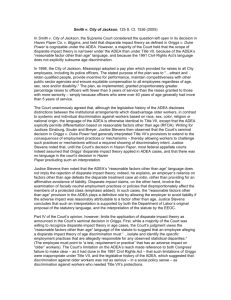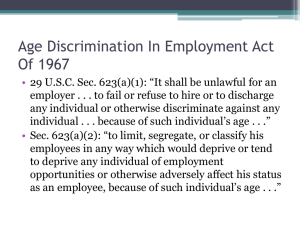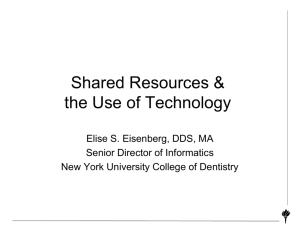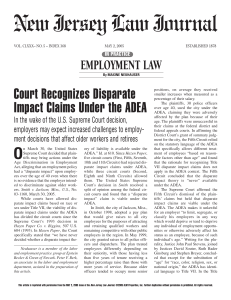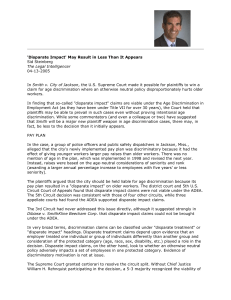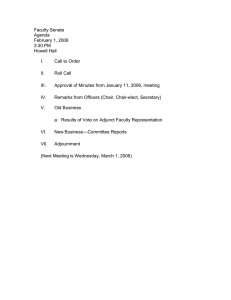Employment All Eyes on the Supreme Court: Does the ADEA
advertisement
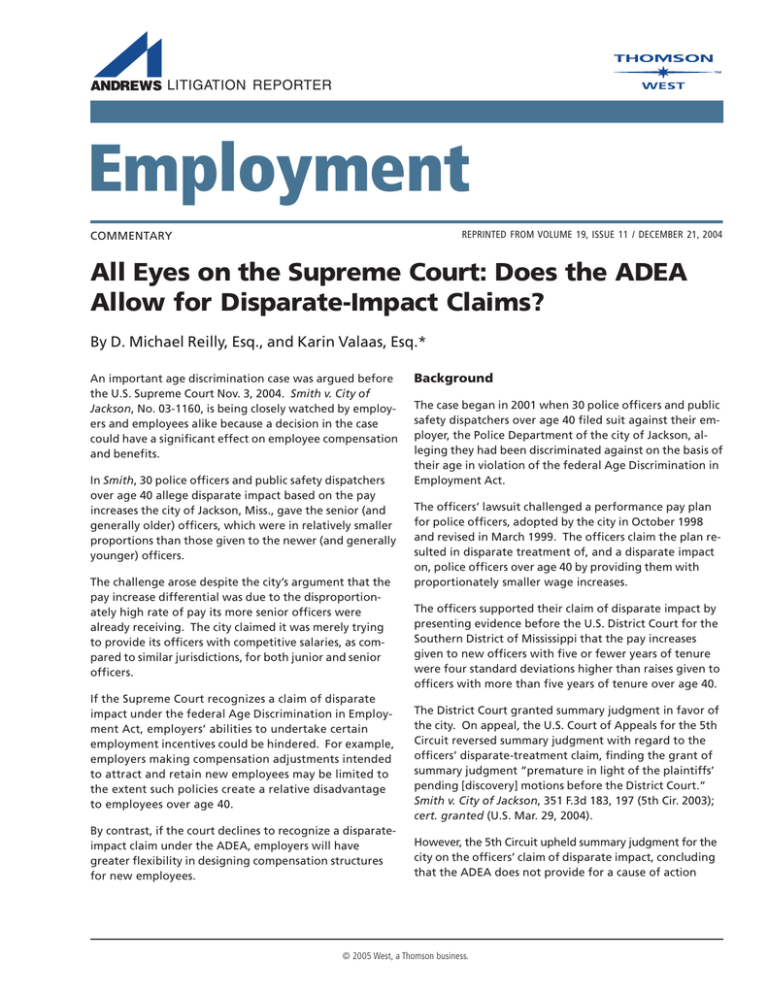
LITIGATION REPORTER Employment LITIGATION REPORTER Employment REPRINTED FROM VOLUME 19, ISSUE 11 / DECEMBER 21, 2004 COMMENTARY All Eyes on the Supreme Court: Does the ADEA Allow for Disparate-Impact Claims? By D. Michael Reilly, Esq., and Karin Valaas, Esq.* An important age discrimination case was argued before the U.S. Supreme Court Nov. 3, 2004. Smith v. City of Jackson, No. 03-1160, is being closely watched by employers and employees alike because a decision in the case could have a significant effect on employee compensation and benefits. In Smith, 30 police officers and public safety dispatchers over age 40 allege disparate impact based on the pay increases the city of Jackson, Miss., gave the senior (and generally older) officers, which were in relatively smaller proportions than those given to the newer (and generally younger) officers. The challenge arose despite the city’s argument that the pay increase differential was due to the disproportionately high rate of pay its more senior officers were already receiving. The city claimed it was merely trying to provide its officers with competitive salaries, as compared to similar jurisdictions, for both junior and senior officers. If the Supreme Court recognizes a claim of disparate impact under the federal Age Discrimination in Employment Act, employers’ abilities to undertake certain employment incentives could be hindered. For example, employers making compensation adjustments intended to attract and retain new employees may be limited to the extent such policies create a relative disadvantage to employees over age 40. By contrast, if the court declines to recognize a disparateimpact claim under the ADEA, employers will have greater flexibility in designing compensation structures for new employees. © 2005 West, a Thomson business. Background The case began in 2001 when 30 police officers and public safety dispatchers over age 40 filed suit against their employer, the Police Department of the city of Jackson, alleging they had been discriminated against on the basis of their age in violation of the federal Age Discrimination in Employment Act. The officers’ lawsuit challenged a performance pay plan for police officers, adopted by the city in October 1998 and revised in March 1999. The officers claim the plan resulted in disparate treatment of, and a disparate impact on, police officers over age 40 by providing them with proportionately smaller wage increases. The officers supported their claim of disparate impact by presenting evidence before the U.S. District Court for the Southern District of Mississippi that the pay increases given to new officers with five or fewer years of tenure were four standard deviations higher than raises given to officers with more than five years of tenure over age 40. The District Court granted summary judgment in favor of the city. On appeal, the U.S. Court of Appeals for the 5th Circuit reversed summary judgment with regard to the officers’ disparate-treatment claim, finding the grant of summary judgment “premature in light of the plaintiffs’ pending [discovery] motions before the District Court.” Smith v. City of Jackson, 351 F.3d 183, 197 (5th Cir. 2003); cert. granted (U.S. Mar. 29, 2004). However, the 5th Circuit upheld summary judgment for the city on the officers’ claim of disparate impact, concluding that the ADEA does not provide for a cause of action © 2005 West, a Thomson business. 1 Employment based on disparate impact. In reaching this conclusion, the 5th Circuit distinguished the ADEA from disparateimpact claims permitted under Title VII: • The text of the ADEA; • The legislative purpose of the ADEA; Fundamental to our decision is the ADEA’s express exception permitting employer conduct based on “reasonable factors other than age” — an exception absent from Title VII — and the inapplicability to the ADEA context of the policy justifications identified by the Supreme Court (in Griggs, 401 U.S. 424, 430-31, 91 S. Ct. 849 [1971]) for recognizing a disparate-impact cause of action in the Title VII context. • Precedent interpreting similar provisions of Title VII of the Civil Rights Act of 1964, as amended in 1991; and • Interpretive guidelines for the ADEA issued by the Equal Employment Opportunity Commission. The Text of the ADEA Id. at 187-88. Prohibited Employer Practices The 5th Circuit found that the “reasonable factors other than age” provision does not create an affirmative defense, which, in turn, would imply a disparate-impact claim under the ADEA. Id. at 191. Instead, the court held this provision “allows the defendant to bring forward evidence to negate the plaintiff’s prima facie case” of disparate treatment. Id. Title VII and the ADEA contain virtually identical language prohibiting certain employer practices. Both statutes declare the following practices to be unlawful: In February 2004 the officers sought review before the U.S. Supreme Court, asking the court to resolve the question of whether disparate-impact claims are cognizable under the ADEA. The officers noted that this question has been addressed by eight circuit courts of appeal and has resulted in a circuit court split, with the 2d, 8th and 9th Circuits permitting claims under the ADEA, and the 1st, 5th, 7th, 10th and 11th Circuits rejecting such claims. The city did not oppose the officers’ petition, and the Court granted certiorari March 29, 2004. The officers filed their brief with the court in June 2004 and were supported by four briefs filed by amici curiae Cornell University Chapter of American Association of University Professors, the Academy of Florida Trial Lawyers, the National Employment Lawyers Association and the Trial Lawyers for Public Justice, and a coalition of groups led by the AARP. The city filed its brief with the court in August 2004. The city’s brief was supported by several amici, including the Equal Employment Advisory Council, the Pacific Legal Foundation, the California Employment Law Council, the U.S. Chamber of Commerce and a coalition of governmental organizations led by the National League of Cities. The parties’ arguments, respectively for and against recognition of a disparate-impact claim under the ADEA, centered on four primary points of interpretation: 2 (1) To fail or refuse to hire or to discharge any individual, or otherwise (to) discriminate against any individual with respect to his compensation, terms, conditions, or privilege of employment, because of such individual’s [protected category]; (or) (2) To limit, segregate, or classify his employees (or applications for employment) in any way which would deprive or tend to deprive any individual of employment opportunities or otherwise adversely affect his status as an employee, because of such individual’s [protected category]. 42 U.S.C. § 2000e-2(a)(1)-(2); 29 U.S.C. § 623(a)(1)-(2) (language in parentheses is only present in Title VII’s provisions). The officers argue that the phrase “because of,” as used in the ADEA, requires only that a plaintiff show causation — not motive. The officers claim that if Congress had intended the statute to address only motive, it would have used words such as “willful” or “knowing.” Thus, the officers reason, an employer policy adversely affecting an employee because of age would violate the statute (unless the employer shows the differentiation is reasonable), even if the policy was not motivated by age. The city takes the position that the phrase “because of” requires motivation. The city claims that this phrase modifies the prohibited employer actions (e.g., refusal to hire, classification) — not the adverse effects referenced in subsection 2 — and reasons that when “because of” modifies an employer action, motivation is necessarily implied. © 2005 West, a Thomson business. Employment Reasonable Factors Other Than Age Both Title VII, 42 U.S.C. § 2000e-2(e)(1), and the ADEA, 29 U.S.C. § 623 (f)(1), provide exceptions to otherwise prohibited acts where use of the protected category is a “bona fide occupational qualification” reasonably necessary to the normal operation of the particular business (the “BFOQ” provision). The ADEA includes an additional exception “where the differentiation is based on reasonable factors other than age” (the “RFOA” provision). The officers argue that the inclusion of the RFOA provision in the statute supports a disparate-impact cause of action. The officers claim that, because the RFOA provision applies in circumstances when an employee is treated differently on the basis of some factor other than age, it necessarily implies that the ADEA may be violated under circumstances where age is not a motive. In other words, plaintiffs may bring claims under the ADEA for a disparate impact on employees over age 40, and employers may defend such a claim by showing the actions was based on a RFOA. Not surprisingly, the city disagrees and argues that the RFOA provision does not provide a defense to a disparateimpact claim but instead addresses the issue of pretext in a disparate-treatment claim. The city claims that the RFOA provision is intended for use to rebut a plaintiff’s claim that the employer’s legitimate nondiscriminatory reason for the disparate treatment was pretext for a bad motive. If effect, the RFOA provision is a tool for showing an action was not motivated by age. Additionally, the city points out that the RFOA provision applies only to “action otherwise prohibited” by Section 623(a) of the ADEA, which the city argues does not include disparateimpact claims. Legislative Purpose and Practical Considerations The officers observe that the purpose of both Title VII and the ADEA is to eliminate discrimination in the workplace and, in furtherance of that goal, the ADEA should recognize claims of disparate impact as does Title VII. Citing the congressional report that preceded and led to the ADEA, the officers argue that a disparate-impact claim would further the report’s recommendation that Congress address the underlying sources of age discrimination that have an unintended adverse effect on older workers. Employer practices that cause a disparate impact and harm employees, even without motivation, are “just as pernicious” when levied against older workers as they are against racial minorities, the officers maintain. © 2005 West, a Thomson business. The city disputes the officer’s broad interpretation of the ADEA’s purpose and argues that the purpose of the ADEA is more limited in scope than the Title VII. For example, the ADEA does not protect younger workers from discrimination in favor of older workers and permits mandatory age-based retirement programs for certain professions. The city emphasizes that, while Title VII was concerned with achieving equal employment opportunities that had historically eluded non-white employees, the ADEA was enacted to redress stereotyped characteristics of older workers. The city also contends that practical implications weigh against recognition of a disparate-impact claim under the ADEA. Unlike Title VII, the ADEA provides a right to jury trial without limitation. The city argues this weighs against recognition of disparate-impact claims under the ADEA because these claims are traditionally tried only before a judge due to the complex nature of such cases. Further, the city claims there is no effective way to measure an impact on a protected class under the ADEA because the protected class is always in flux, as individuals continually turn 40 and enter the protected realm. The city argues that an adverse impact on workers over age 40 is simply not probative because the disparity maybe caused by a wide variety of factors. Supreme Court Precedent: Griggs v. Duke Power Co. In 1971 the U.S. Supreme Court ruled in Griggs v. Duke Power Co. that disparate-impact claims could be brought under Title VII. 401 U.S. 424, 91 S. Ct. 849, 28 L. Ed. 2d 158 (1971). The court briefly reviewed congressional objectives underlying Title VII, which included “remov[ing] barriers that have operated in the past to favor an identifiable group of white employees over other employees.” Id. at 429-30. In reaching its conclusion the court reasoned, in part, “Congress directed the thrust of [Title VII] to the consequences of employment practices, not simply the motivation.” Id. at 432. The officers claim the Griggs’ analysis of Title VII language is directly applicable to the parallel language of the ADEA, and they argue that disparate-impact claims must be recognized under the ADEA accordingly. To support their claim, the officers state that other provisions in the ADEA with similar counterparts in Title VII were also interpreted according to Title VII precedent. The officers also note that Congress accepted the Griggs court’s interpretation of Title VII as including disparate 3 Employment impact by providing additional statutory guidelines for disparate-impact claims in the 1991 amendments to that statute. The city counters that the Griggs analysis is based on the specific congressional objectives related to Title VII, as discussed by the high court, and is not applicable to the ADEA based on the differences between congressional objectives of the ADEA and Title VII. The city also argues that when the ADEA was enacted, prior to the Griggs decision, the prevailing view was that discrimination requires motive based on a protected trait to be unlawful under the statute. Pointing to the court’s recent decision in General Dynamics v. Cline, 540 U.S. 581 (U.S. 2004), the city claims that the court has acknowledged that the scope of the phrase “because of age” under the ADEA is different from scope of the phrase “because of race … [or] … sex” under Title VII. Thus, these seemingly similar phrases cannot be interpreted the same. EEOC Interpretive Regulations The officers contend that the EEOC’s regulation has been consistently maintained by the agency for “decades” without being altered by Congress and, as a result, Congress can be deemed to have acquiesced to the regulatory language. In contrast, the city contends that the regulation cannot logically be read as prohibiting disparate impact because it does not interpret prohibited acts under the ADEA, rather it describes “lawful practices.” The city also argues that the regulation does not merit deference because: the regulation varies from the EEOC’s original interpretation of the ADEA, which said that the reasonableness of a differentiation should be determined on an individualized basis; the change in EEOC’s guideline was “precipitous” and did not consider whether subsection 623(a) permitted disparate-impact analysis; the guideline is unreasonable as it requires employers show the higher standard of “business necessity” to meet the statute’s “reasonable factor other than age” requirement; and the court has previously held EEOC interpretations of the ADEA as contrary to law. A decision in the case is expected by summer 2005. The EEOC has adopted a regulation interpreting 29 U.S.C. § 623(f)(1) of the ADEA, which contains the RFOA provision. The regulation states: When an employment practice … is claimed as a basis for different treatment of employees … on the grounds that it is a “factor other than” age, and such a practice has an adverse impact on individuals within the protected age group, it can only be justified as a business necessity. 29 C.F.R. § 1625.7. The officers claim the EEOC regulation should be followed because it correctly interprets the ADEA and it follows the Supreme Court’s reasoning in Griggs. The o”fficers contend that to find the EEOC’s regulations unreasonable would require the court to find the Griggs decision unreasonable. Further, the officers argue that the EEOC regulations must be given considerable deference under the standard enunciated by the Supreme Court in Chevron USA Inc. v. Natural Resources Defense Council Inc., 468 U.S. 1227 (1984). Deference is warranted, according to the officers, because Congress specifically delegated rule-making authority to the EEOC as necessary or appropriate for carrying out the ADEA. 4 A decision in favor of the officers, and recognizing a claim of disparate impact under the ADEA, will likely be followed by further court proceedings at the district court level. Once the decision has been handed down, employers would be well advised to take a close look at their wages and benefits plans to prevent being put into a situation similar to that of the city of Jackson. * D. Michael Reilly is a partner and co-chair of the labor and employment department at Lane Powell Spears Lubersky PLLC. He concentrates his practice on employment litigation and advice, specializing in claims involving wrongful discharge, wage/hour issues, the Employment Retirement Income Security Act, as well as race, sex, religion and disability. He can be reached at reillym@lanepowell.com or (206) 223-7051. Karin E. Valaas is an attorney in the Seattle office of Lane Powell. She concentrates her practice on employment issues. Karin has had experience as a paralegal specialist in the honors program with the U.S. Justice Department’s Antitrust Division in Washington, D.C., and served as a legislative intern for Sen. Patty Murray (D-Wash). She can be reached at valaask@lanepowell.com or at (206) 223-7043. © 2005 West, a Thomson business.
